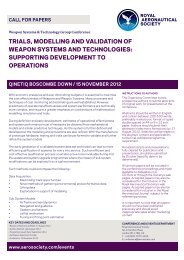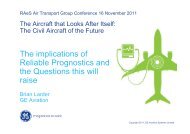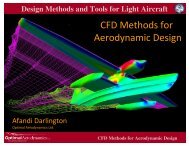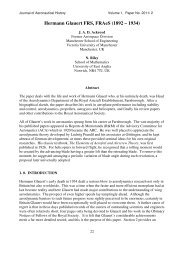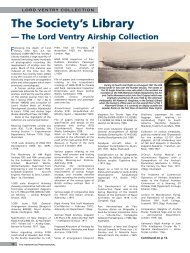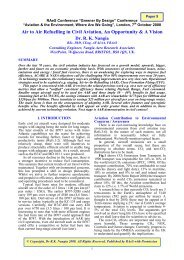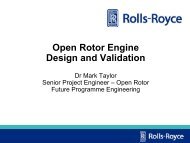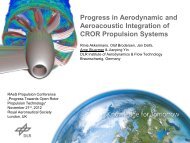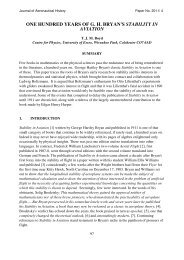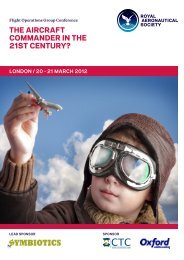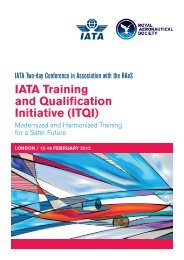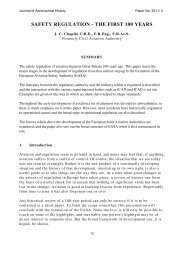Unmanned Aircraft in Border Patrol Activities
Unmanned Aircraft in Border Patrol Activities
Unmanned Aircraft in Border Patrol Activities
Create successful ePaper yourself
Turn your PDF publications into a flip-book with our unique Google optimized e-Paper software.
Annual UAS Conference – Operational and Technology Read<strong>in</strong>ess<br />
25 th – 26 th September 2011 Conference<br />
<strong>Unmanned</strong> <strong>Aircraft</strong><br />
<strong>in</strong> <strong>Border</strong> <strong>Patrol</strong> <strong>Activities</strong><br />
Dr Joseph Barnard<br />
joseph.barnard@barnardmicrosystems.com<br />
Barnard Microsystems Limited<br />
Unit 4, 44 – 54 Coleridge Road<br />
London N8 8ED U.K.
Nature of border patrol work.<br />
• Monitor shipp<strong>in</strong>g, e.g. ships load<strong>in</strong>g oil at oil rigs<br />
• Monitor fish<strong>in</strong>g activities <strong>in</strong> exclusive economic zones<br />
• Detect small pirate boats<br />
• Detect Self Propelled Semi-Submergible (SPSS) vessels<br />
• Detect the movement of people on foot and <strong>in</strong> vehicles<br />
• Detect people, drug and weapon traffick<strong>in</strong>g activities<br />
• Day and night time surveillance<br />
• Real time, high def<strong>in</strong>ition, still image and video feed<br />
• Ability to read number plates and names on ships and identify small arms and RPG<br />
• <strong>Aircraft</strong> range <strong>in</strong> excess of 300 km; payload from 4 to 10 kg<br />
SPSS<br />
<strong>Unmanned</strong> <strong>Aircraft</strong> <strong>in</strong> <strong>Border</strong> <strong>Patrol</strong> <strong>Activities</strong> 2
The digital camera is the most typical sensor used <strong>in</strong> border patrol work.<br />
Above: side look<strong>in</strong>g photograph us<strong>in</strong>g a 100mm MACRO lens and camera travell<strong>in</strong>g at 30 mph.<br />
In the above photographs, us<strong>in</strong>g a professional “L” series image stabilised Canon lens:<br />
ISO sett<strong>in</strong>g = 800<br />
shutter speed = 1/2,000 second<br />
<strong>Unmanned</strong> <strong>Aircraft</strong> <strong>in</strong> <strong>Border</strong> <strong>Patrol</strong> <strong>Activities</strong> 3
1.6 kg ImSar NanoSAR B us<strong>in</strong>g less than 30 Watts of electrical power.<br />
<strong>Unmanned</strong> <strong>Aircraft</strong> <strong>in</strong> <strong>Border</strong> <strong>Patrol</strong> <strong>Activities</strong> 4
Detection of ships <strong>in</strong> all weather conditions us<strong>in</strong>g Synthetic Aperture RADAR.<br />
<strong>Unmanned</strong> <strong>Aircraft</strong> <strong>in</strong> <strong>Border</strong> <strong>Patrol</strong> <strong>Activities</strong> 5
Example of manned aircraft currently used <strong>in</strong> border patrol work.<br />
Dash 8 Maritime <strong>Patrol</strong> <strong>Aircraft</strong> (MPA) for the U.S. Department of Homeland Security -<br />
Customs and <strong>Border</strong> <strong>Patrol</strong> (CBP).<br />
<strong>Unmanned</strong> <strong>Aircraft</strong> <strong>in</strong> <strong>Border</strong> <strong>Patrol</strong> <strong>Activities</strong> 6
Could unmanned aircraft be used <strong>in</strong> border patrol work?<br />
<strong>Unmanned</strong> <strong>Aircraft</strong> <strong>in</strong> <strong>Border</strong> <strong>Patrol</strong> <strong>Activities</strong> 7
The SINUE Project looked <strong>in</strong>to the use of unmanned aircraft <strong>in</strong> border patrol work<br />
SINUE was an ESA funded Project, <strong>in</strong> which Indra considered the<br />
case of maritime border patrol off the Canary Islands.<br />
<strong>Unmanned</strong> <strong>Aircraft</strong> <strong>in</strong> <strong>Border</strong> <strong>Patrol</strong> <strong>Activities</strong> 8
Predator B unmanned aircraft patroll<strong>in</strong>g the U.S. Southwest border.<br />
“Thanks to the addition of two more Predator B unmanned aircraft to the exist<strong>in</strong>g fleet, the<br />
U.S. Customs and <strong>Border</strong> <strong>Patrol</strong> is now conduct<strong>in</strong>g aerial patrols of virtually the entire U.S.<br />
Southwest border from California to the Gulf of Mexico <strong>in</strong> Texas, accord<strong>in</strong>g to the Department<br />
of Homeland Security (DHS).<br />
The expanded Predator B flights, orig<strong>in</strong>at<strong>in</strong>g from Corpus Christy, Texas, are be<strong>in</strong>g flown<br />
courtesy of $600 million <strong>in</strong> new fund<strong>in</strong>g <strong>in</strong>cluded <strong>in</strong> the recently passed Southwest border<br />
security bill.<br />
From http://usgov<strong>in</strong>fo.about.com/b/2010/09/02/predators-now-patrol-entire-southwest-border.htm<br />
<strong>Unmanned</strong> <strong>Aircraft</strong> <strong>in</strong> <strong>Border</strong> <strong>Patrol</strong> <strong>Activities</strong> 9
Advantages of us<strong>in</strong>g smaller unmanned aircraft <strong>in</strong> border patrol work.<br />
<strong>Unmanned</strong> aircraft with two, or more, eng<strong>in</strong>es, a Maximum Take-Off Weight of 35 kg, or less,<br />
and a range <strong>in</strong> excess of 300 km have the follow<strong>in</strong>g advantages <strong>in</strong> border patrol work:<br />
they will cause less damage <strong>in</strong> the event of a crash<br />
they are generally less complex to operate and / or ma<strong>in</strong>ta<strong>in</strong> (smaller logistical footpr<strong>in</strong>t)<br />
they are less expensive to acquire, or lease, and are less expensive to operate<br />
they are more reliable (if they can fly on 1 eng<strong>in</strong>e) than an aircraft with 1 piston eng<strong>in</strong>e<br />
it is easier to get approval to export the unmanned aircraft for use throughout the world<br />
We are develop<strong>in</strong>g the InView unmanned aircraft for use <strong>in</strong> the follow<strong>in</strong>g applications:<br />
scientific volcanic ash cloud density monitor<strong>in</strong>g<br />
commercial oil and m<strong>in</strong>eral exploration work and pipel<strong>in</strong>e monitor<strong>in</strong>g<br />
state land and maritime border patrol work<br />
<strong>Unmanned</strong> <strong>Aircraft</strong> <strong>in</strong> <strong>Border</strong> <strong>Patrol</strong> <strong>Activities</strong> 10
Introduction to the InView unmanned aircraft.<br />
Two eng<strong>in</strong>es for safety.<br />
It’s no use hav<strong>in</strong>g quad redundant flight<br />
control systems if the UA has one eng<strong>in</strong>e<br />
Big wheels for operation from rough terra<strong>in</strong><br />
Lightweight: 20 kg without fuel and payload<br />
M<strong>in</strong>imised crash damage and simplified<br />
flight regulations.<br />
Modular construction for<br />
ease of transportation,<br />
ma<strong>in</strong>tenance and upgrade<br />
<strong>Unmanned</strong> <strong>Aircraft</strong> <strong>in</strong> <strong>Border</strong> <strong>Patrol</strong> <strong>Activities</strong> 11
InView unmanned aircraft features at a glance.<br />
for scientific, commercial and state missions Payload 4 kg<br />
comprehensive safety features Endurance 7+ hours<br />
modular and easily transportable Max speed 112 kph<br />
assembled and tested with<strong>in</strong> an hour Loiter speed 24 kph<br />
can operate from a grass field Weight 19.5 kg without fuel<br />
capable of very slow flight W<strong>in</strong>gspan 4 m<br />
user def<strong>in</strong>able payloads can be carried Fuel Gasol<strong>in</strong>e + synthetic oil 20:1<br />
operates <strong>in</strong> manual, Microprocessor based<br />
autopilot and PC autopilot flight modes:<br />
mov<strong>in</strong>g towards more automation to reduce<br />
the errors <strong>in</strong>troduced by human <strong>in</strong>volvement.<br />
Propulsion<br />
2x SAITO FG-30 eng<strong>in</strong>es<br />
Total Power = 3.6 kW<br />
<strong>Unmanned</strong> <strong>Aircraft</strong> <strong>in</strong> <strong>Border</strong> <strong>Patrol</strong> <strong>Activities</strong> 12
The <strong>in</strong>struments carried on the unmanned aircraft can be expensive.<br />
To detect difficult targets <strong>in</strong> all weather conditions, the unmanned aircraft might carry:<br />
An ImSAR NanoSAR B unit cost<strong>in</strong>g $ 95,000 (budgetary price)<br />
two Sc<strong>in</strong>trex CS-3SL Cesium beam magnetometers, total cost $ 40,400<br />
an airborne broadband satellite communications term<strong>in</strong>al cost<strong>in</strong>g $ 35,000 (budgetary)<br />
<strong>Unmanned</strong> <strong>Aircraft</strong> <strong>in</strong> <strong>Border</strong> <strong>Patrol</strong> <strong>Activities</strong> 13
Safety and reliability features.<br />
use of dual flight control units:<br />
o manual flight control for flight tra<strong>in</strong><strong>in</strong>g and emergency control<br />
o microprocessor based flight control for safe, but not very versatile, flight control<br />
o PC based flight control for flexibility and experimentation, but less safe flight control<br />
automatic take-off us<strong>in</strong>g the Sky Circuits SC2 autopilot (shown below) to reduce the<br />
consequences of human error and ease the logistical footpr<strong>in</strong>t<br />
automatic land<strong>in</strong>g us<strong>in</strong>g the Sky Circuits SC2 autopilot to enable emergency land<strong>in</strong>gs and<br />
reduce the consequences of human error<br />
distributed, on-board sensor network to provide early detection of potential failures, so<br />
measures can be taken before a more serious condition develops<br />
dual rudder as part of a dual redundant safety system<br />
dual elevator as part of a dual redundant safety system<br />
tw<strong>in</strong> eng<strong>in</strong>es, the aircraft can fly on one eng<strong>in</strong>e alone<br />
parachute deployment to reduce the k<strong>in</strong>etic energy<br />
<strong>Unmanned</strong> <strong>Aircraft</strong> <strong>in</strong> <strong>Border</strong> <strong>Patrol</strong> <strong>Activities</strong> 14
Accidents and safety.<br />
Event Comment Ascribed to<br />
IV-01 sheared off undercarriage pre-flight check error human error<br />
IV-02 crash after failure of one eng<strong>in</strong>e lack of situational awareness design error<br />
pre-flight check deficiency human error<br />
IV-03 crash due to little rudder authority design deficiency design error<br />
IV-05 manually landed on top of tall trees pilot perception error human error<br />
IV-06 sheared off undercarriage hard manual land<strong>in</strong>g human error<br />
IV-07 sheared off undercarriage hard manual land<strong>in</strong>g human error<br />
design deficiency design error<br />
Most accidents occurred dur<strong>in</strong>g take-off and land<strong>in</strong>g. So, as far as we are concerned,<br />
unmanned aircraft test<strong>in</strong>g <strong>in</strong> the U.K. under CAA CAP 722 regulations is f<strong>in</strong>e.<br />
Our test flight experience has conv<strong>in</strong>ced us that the human is the weak l<strong>in</strong>k, and that more<br />
pre-flight test automation and flight control mach<strong>in</strong>e <strong>in</strong>telligence will lead to <strong>in</strong>creased safety.<br />
<strong>Unmanned</strong> <strong>Aircraft</strong> <strong>in</strong> <strong>Border</strong> <strong>Patrol</strong> <strong>Activities</strong> 15
The key barriers to the use of unmanned aircraft <strong>in</strong> civil and state applications.<br />
The frequently mentioned barriers are suggested to be:<br />
• Regulations<br />
• Sense and avoid system<br />
• Safety<br />
• Air worth<strong>in</strong>ess<br />
• Type certification<br />
• ATM Integration<br />
• Availability of radio spectrum<br />
• Air crew tra<strong>in</strong><strong>in</strong>g<br />
• Human factors and autonomy<br />
• Public perception<br />
An important barrier that is rarely mentioned is:<br />
• Long term reliability of small eng<strong>in</strong>es<br />
Small eng<strong>in</strong>es have a really tough time:<br />
• <strong>in</strong>creased wear due to higher RPM operation<br />
• particulates <strong>in</strong> the fuel clog small fuel tubes<br />
• Carbon build-up due to the fuel : oil mixture<br />
The tw<strong>in</strong> cyl<strong>in</strong>der SAITO FG-57T four<br />
stroke eng<strong>in</strong>e is an example of an eng<strong>in</strong>e<br />
used on long range unmanned aircraft.<br />
<strong>Unmanned</strong> <strong>Aircraft</strong> <strong>in</strong> <strong>Border</strong> <strong>Patrol</strong> <strong>Activities</strong> 16
Example of advanced small eng<strong>in</strong>e technology from Currawong Eng<strong>in</strong>eer<strong>in</strong>g.<br />
Currawong Eng<strong>in</strong>eer<strong>in</strong>g, located <strong>in</strong> Australia, have developed an Electronic Fuel Injection unit<br />
for use on small gasol<strong>in</strong>e and heavy fuel eng<strong>in</strong>es, operat<strong>in</strong>g up to 20,000 feet to give them:<br />
• <strong>in</strong>creased power output<br />
• <strong>in</strong>creased torque output<br />
• <strong>in</strong>creased fuel efficiency<br />
• ease of start<strong>in</strong>g <strong>in</strong> cold weather<br />
Ray Cooper, Monash University's UA pilot, gets a brief<strong>in</strong>g from Gav<strong>in</strong> Brett, Lead Development<br />
Eng<strong>in</strong>eer for Aerosonde Ltd. The stunn<strong>in</strong>g long range capability of the Aerosonde, the first<br />
<strong>Unmanned</strong> <strong>Aircraft</strong> to cross the Atlantic, is very much a tribute to the skills of Gav<strong>in</strong> Brett.<br />
Gav<strong>in</strong> is now the CEO and Director of Currawong Eng<strong>in</strong>eer<strong>in</strong>g <strong>in</strong> Tasmania.<br />
<strong>Unmanned</strong> <strong>Aircraft</strong> <strong>in</strong> <strong>Border</strong> <strong>Patrol</strong> <strong>Activities</strong> 17
U.K. Military and Strategic Export Control List.<br />
Schedule 3 U.K. controlled dual-use Goods, Software and Technology<br />
Category 9 Aerospace and Propulsion<br />
9A Systems, Equipment and Components<br />
9A012 "<strong>Unmanned</strong> Aerial Vehicles", associated systems, equipment and components, as follows:<br />
9A012.a. UAVs hav<strong>in</strong>g any of the follow<strong>in</strong>g:<br />
9A012.a1.<br />
9A012.a2.<br />
An autonomous flight control and navigation capability (e.g. an autopilot with an Inertial<br />
Navigation System); or<br />
Capability of controlled flight out of the direct vision range <strong>in</strong>volv<strong>in</strong>g a human operator<br />
(e.g. televisual remote control);<br />
9A012.b. Associated systems, equipment and components, as follows:<br />
9A012.b1. Equipment specially designed for remotely controll<strong>in</strong>g the "UAVs" specified <strong>in</strong> 9A012.a<br />
9A012.b2.<br />
9A012.b4.<br />
Systems for navigation, attitude, guidance or control other than those specified <strong>in</strong> 7A and<br />
specially designed to provide autonomous flight control or navigation capability to "UAVs"<br />
specified <strong>in</strong> 9A012.a;<br />
Air breath<strong>in</strong>g reciprocat<strong>in</strong>g or rotary <strong>in</strong>ternal combustion type eng<strong>in</strong>es, specially designed<br />
to propel "UAVs" at altitudes above 50,000 feet (15,240 metres).<br />
<strong>Unmanned</strong> <strong>Aircraft</strong> <strong>in</strong> <strong>Border</strong> <strong>Patrol</strong> <strong>Activities</strong> 18
Missile Technology Control Regime (“MTCR”) export controls.<br />
• If the UAV has a range <strong>in</strong> excess of 300 km, and a payload <strong>in</strong> excess of 500 kg, then the<br />
UAV falls <strong>in</strong> Category I "Complete Delivery Systems" Item 1 Part 1.A.2 and gett<strong>in</strong>g export<br />
approval is that much more difficult.<br />
• If the UAV has a range <strong>in</strong> excess of 300 km, and a payload of less than 500 kg, as many<br />
unmanned aircraft do, then the UAV falls <strong>in</strong> Category II "Other Complete Delivery<br />
Systems" Item 19 Part 19.A.2 , and gett<strong>in</strong>g a Standard Individual Export License is easier.<br />
<strong>Unmanned</strong> <strong>Aircraft</strong> <strong>in</strong> <strong>Border</strong> <strong>Patrol</strong> <strong>Activities</strong> 19
Phase 1: L<strong>in</strong>e Of Sight (“LOS”) operation dur<strong>in</strong>g take-off and land<strong>in</strong>g.<br />
Rx / Tx Frequency GHz Description<br />
Rx 1.22760 precision GPS PRBS L2 signal, upper and lower 10 MHz side bands<br />
Rx 1.57542 precision GPS PRBS L1 signal, upper and lower 10 MHz side bands<br />
Rx 2.400 to 2.483 spread spectrum upl<strong>in</strong>k for manual flight control at 819.2 kbit/sec<br />
GCS<br />
500 m<br />
400 feet<br />
<strong>Unmanned</strong> <strong>Aircraft</strong> <strong>in</strong> <strong>Border</strong> <strong>Patrol</strong> <strong>Activities</strong> 20
Phase 2: Radio L<strong>in</strong>e Of Sight (“RLOS”) operation dur<strong>in</strong>g border patrol mission.<br />
Rx / Tx Frequency GHz Description<br />
Rx 1.5250 to 1.6605 Inmarsat satellite broadband downl<strong>in</strong>k at 64 kbps<br />
Tx 1.6252 to 1.6605 Inmarsat satellite broadband upl<strong>in</strong>k at 64 kbps<br />
Rx & Tx 5.725 to 5.850 Wireless Ethernet bridge IEEE 802.11a OFDM l<strong>in</strong>k at 6 Mbps<br />
Rx sensitivity is -74 dBm at 54 Mbps and -94 dBm at 6 Mbps<br />
PI 3.141592654<br />
Circum Earth (Polar) 40008 km<br />
Radius Earth 6367.470963 km<br />
Height tree 10 m<br />
Distance to tree 300 m<br />
Angle to horizontal 1.909152433 degrees<br />
Angle total 91.90915243 degrees<br />
RLOS range 60 km<br />
RHS 40573742.21 km^2<br />
H m<strong>in</strong>imum<br />
2.281 km<br />
7484 feet<br />
RLOS volume<br />
LOS<br />
60 km<br />
UA on RLOS border patrol at 8,000 to 12,000 feet above MSL<br />
<strong>Unmanned</strong> <strong>Aircraft</strong> <strong>in</strong> <strong>Border</strong> <strong>Patrol</strong> <strong>Activities</strong> 21
The InView avionics architecture uses an Ethernet based connectivity.<br />
Ground 60 km range<br />
Control<br />
Station<br />
Ethernet<br />
bridge<br />
PTZ IP camera<br />
CAM 1<br />
Ethernet<br />
Ethernet HUB<br />
Ethernet<br />
On the UA<br />
Intel S<strong>in</strong>gle<br />
Board<br />
Computer<br />
Ethernet<br />
USB<br />
Fast Solid<br />
State Hard<br />
Drive<br />
SATA<br />
Interface to<br />
Flight<br />
Control Unit<br />
USB<br />
IMU +<br />
GPS unit<br />
Intel S<strong>in</strong>gle Board Computer<br />
Intel S<strong>in</strong>gle Board Computer<br />
real time sensor data process<strong>in</strong>g<br />
Digital Camera<br />
Canon EOS 5D Mk II<br />
USB<br />
<strong>Unmanned</strong> <strong>Aircraft</strong> <strong>in</strong> <strong>Border</strong> <strong>Patrol</strong> <strong>Activities</strong> 22
The InView Ground Control Station and Data Process<strong>in</strong>g Centre.<br />
Internet<br />
HPC Cluster<br />
Automated Data Process<strong>in</strong>g<br />
Ethernet<br />
PC #1<br />
Flight CTRL<br />
Ethernet<br />
Ethernet<br />
bridge<br />
Ethernet<br />
Ethernet HUB<br />
PC #2<br />
Comms + HM<br />
60 km range<br />
Ethernet<br />
PC #3<br />
Payload<br />
Ground Control Station<br />
unmanned<br />
aircraft<br />
<strong>Unmanned</strong> <strong>Aircraft</strong> <strong>in</strong> <strong>Border</strong> <strong>Patrol</strong> <strong>Activities</strong> 23
Two unmanned aircraft on patrol can provide improved identification capability.<br />
UA at 8,000 feet AGL provides wide area coverage<br />
2.4 GHz IEEE 802.11N WLAN l<strong>in</strong>k<br />
UA fly<strong>in</strong>g at 400 feet AGL<br />
provides high resolution<br />
side look<strong>in</strong>g image for ID<br />
<strong>Unmanned</strong> <strong>Aircraft</strong> <strong>in</strong> <strong>Border</strong> <strong>Patrol</strong> <strong>Activities</strong> 24
Ground Control Station handover is advantageous <strong>in</strong> the patrol of long borders.<br />
<strong>Unmanned</strong> <strong>Aircraft</strong> <strong>in</strong> <strong>Border</strong> <strong>Patrol</strong> <strong>Activities</strong> 25
Conclusions<br />
<strong>Border</strong> <strong>Patrol</strong> us<strong>in</strong>g unmanned aircraft has already started with Predator B unmanned aircraft<br />
be<strong>in</strong>g used to monitor the US Southwest border with Mexico.<br />
Smaller unmanned aircraft with a Maximum Take-Off Weight of less than 35 kg have<br />
advantages over the use of heavier, and usually larger, unmanned aircraft, especially <strong>in</strong> lower<br />
leas<strong>in</strong>g and operational costs and reduced impact of a crash.<br />
In order to relay the high bandwidth video stream from the unmanned aircraft to the Ground<br />
Control Station, the UA needs to rema<strong>in</strong> with<strong>in</strong> Radio L<strong>in</strong>e Of Sight (60 to 250 km) of the GCS.<br />
GCS handover capability is useful <strong>in</strong> the patroll<strong>in</strong>g of a border outside of the RLOS range.<br />
Acknowledgements<br />
1. The Technology Strategy Board (“TSB”) <strong>in</strong> the STUAC Project to <strong>in</strong>corporate sensors to<br />
monitor the health of an <strong>Unmanned</strong> <strong>Aircraft</strong>.<br />
2. The TSB <strong>in</strong> the INMARA Intelligent Mach<strong>in</strong>e Reason<strong>in</strong>g and Action Feasibility Study<br />
3. The European Space Agency <strong>in</strong> the form of the UASatCom IAP Feasibility Study<br />
I can be contacted at joseph.barnard@barnardmicrosystems.com<br />
<strong>Unmanned</strong> <strong>Aircraft</strong> <strong>in</strong> <strong>Border</strong> <strong>Patrol</strong> <strong>Activities</strong> 26
Thank you.<br />
Dr Joseph Barnard<br />
joseph.barnard@barnardmicrosystems.com<br />
Barnard Microsystems Limited<br />
<strong>Unmanned</strong> <strong>Aircraft</strong> <strong>in</strong> <strong>Border</strong> <strong>Patrol</strong> <strong>Activities</strong> 27



